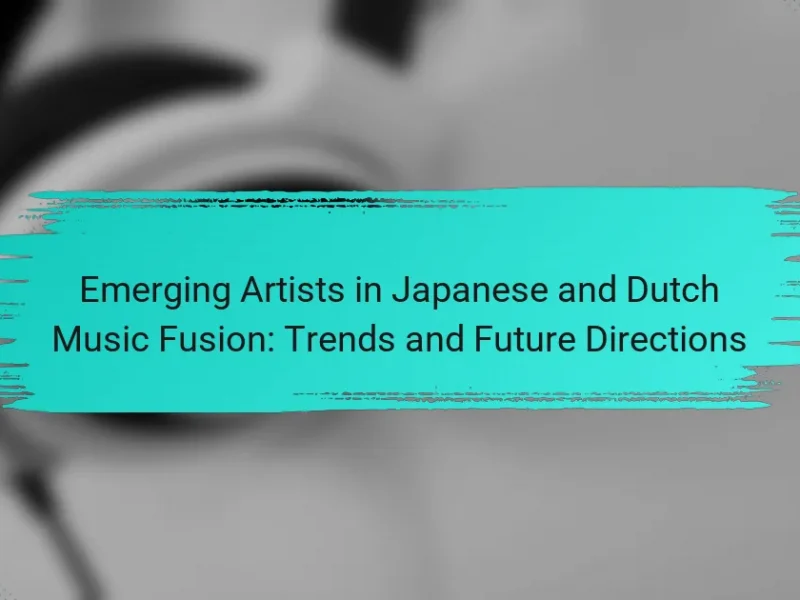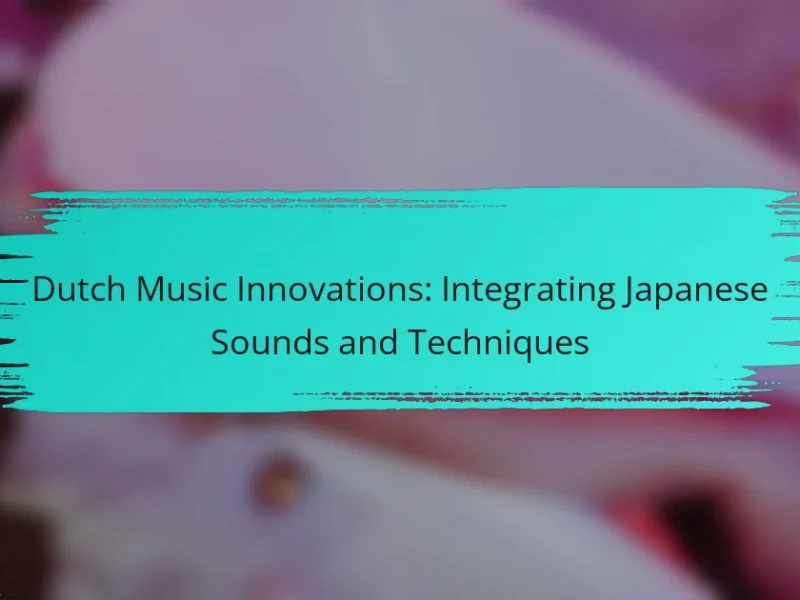Cross-cultural music education fosters creativity and collaboration by merging diverse methodologies. This article explores the holistic approach of Japanese music education, emphasizing traditional practices, and the Dutch focus on individual expression and technological integration. It examines cultural influences, unique pedagogical methods, and successful case studies that highlight the fusion of these two distinct educational philosophies. Finally, it discusses future trends shaping this dynamic field.
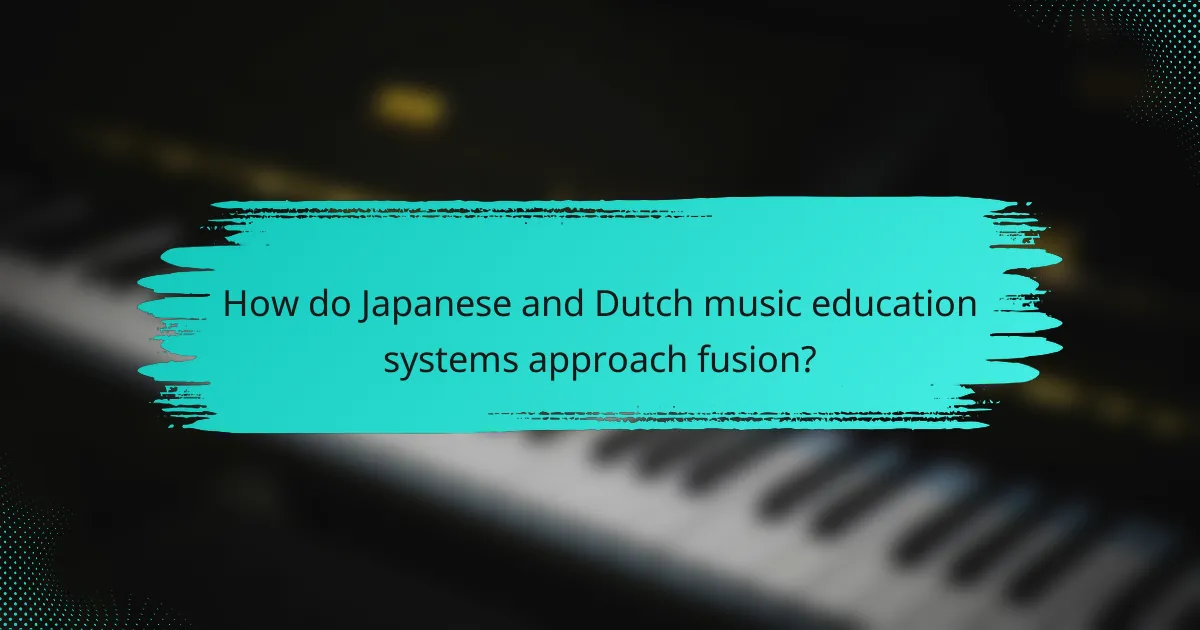
How do Japanese and Dutch music education systems approach fusion?
Japanese and Dutch music education systems approach fusion by integrating traditional methods with contemporary practices. Japan emphasizes a holistic approach, blending classical techniques with modern genres, fostering creativity. In contrast, the Netherlands prioritizes collaborative learning and intercultural exchange, encouraging students to explore diverse musical styles. Both systems value adaptability, promoting innovative fusion that reflects cultural diversity.
What are the foundational principles of music education in Japan?
The foundational principles of music education in Japan emphasize cultural integration, creativity, and community involvement. Japanese music education fosters a deep appreciation for traditional forms while encouraging innovation through contemporary practices. This dual approach nurtures students’ musical skills and cultural identity.
Key elements include experiential learning, where students engage in hands-on activities, and collaborative projects that promote teamwork. Additionally, the curriculum often incorporates traditional instruments, enhancing students’ connection to their heritage. As a result, music education in Japan not only develops technical proficiency but also enriches cultural understanding and social harmony.
What are the foundational principles of music education in the Netherlands?
The foundational principles of music education in the Netherlands emphasize creativity, inclusivity, and cultural diversity. These principles encourage students to explore various musical traditions, fostering a rich understanding of music’s role in society.
One key aspect is the integration of different cultural perspectives, allowing learners to appreciate both local and global music forms. This approach promotes cross-cultural collaboration, enhancing students’ adaptability and innovation in music-making.
Furthermore, the Dutch music education system values experiential learning. Students engage in active music-making, which builds their confidence and skills. This hands-on experience is crucial for developing a lifelong appreciation for music.
Lastly, a focus on individual expression is central to the curriculum. Students are encouraged to develop their unique musical voices, contributing to a vibrant and diverse music landscape in the Netherlands.
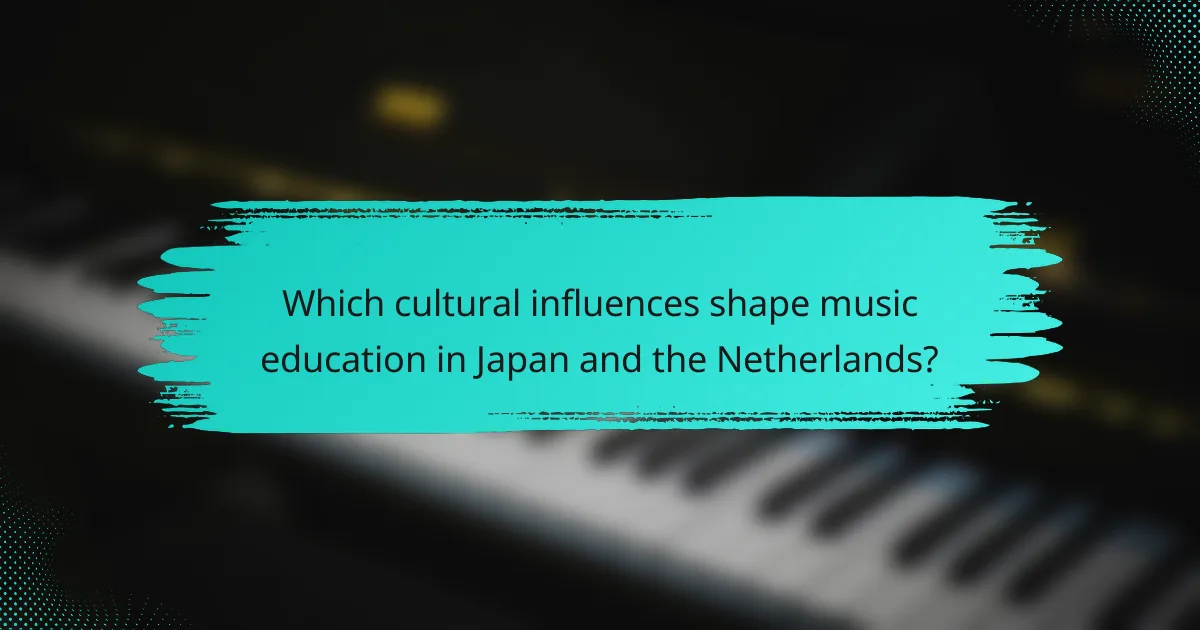
Which cultural influences shape music education in Japan and the Netherlands?
Cultural influences in Japan and the Netherlands shape music education through distinct philosophies and practices. Japan emphasizes traditional forms and group harmony, while the Netherlands promotes innovation and individual expression.
Japanese music education often integrates cultural heritage, focusing on instruments like the koto and shamisen, promoting collective participation. In contrast, Dutch music education encourages diverse genres, fostering creativity through contemporary styles and technology.
Both countries value music’s role in social development, but their methods differ. Japan’s approach centers on discipline and respect for tradition, whereas the Netherlands embraces experimentation and cross-genre exploration. This fusion creates a rich tapestry of musical education, merging historical roots with modern influences.
How does traditional Japanese music influence contemporary education?
Traditional Japanese music profoundly influences contemporary education by integrating cultural heritage into learning frameworks. This approach fosters creativity and appreciation for diverse musical forms.
In Japan, traditional music emphasizes collective participation, encouraging collaboration among students. This method contrasts with the more individualistic Dutch approach, where personal expression is prioritized.
Moreover, incorporating elements of Japanese music, such as scales and rhythms, enhances students’ understanding of global music theory. As a result, students develop a broader perspective on cultural diversity.
Educational programs that blend these traditions create a unique fusion, enriching the curriculum and promoting cross-cultural understanding. This synergy prepares students for a globalized world.
What role does Dutch folk music play in music education practices?
Dutch folk music plays a significant role in music education by fostering cultural appreciation and creativity. Integrating Dutch folk music into curricula enhances students’ understanding of musical diversity. It encourages participation, promotes teamwork, and develops performance skills. Unique attributes of Dutch folk music, such as its use of traditional instruments like the accordion and fiddle, provide students with hands-on experience. This approach enriches cross-cultural music education, particularly when combined with Japanese music, creating a fusion that broadens students’ musical horizons.

What pedagogical methods are unique to Japanese music education?
Japanese music education employs unique pedagogical methods such as the emphasis on group performance and oral transmission. These methods foster collaboration and cultural continuity. For example, traditional practices like “kumi-daiko” involve group drumming, promoting teamwork. Additionally, the use of “shamisen” and “koto” in lessons emphasizes hands-on learning. This approach contrasts with Dutch methods that prioritize individual creativity and structured curricula. The focus on community and tradition in Japan enhances collective musical experiences.
How is the Suzuki method implemented in Japanese music schools?
The Suzuki method is implemented in Japanese music schools through a nurturing approach that emphasizes listening, imitation, and early exposure to music. Students begin learning instruments at a young age, often as young as three, fostering a strong foundation in musicality.
Teachers play a crucial role, guiding students through a repertoire of pieces that develop technique and expression. Parental involvement is significant; parents attend lessons and support practice at home, creating a collaborative learning environment.
This method focuses on developing aural skills before reading music, allowing children to internalize musical concepts naturally. As a result, students often demonstrate high levels of musical proficiency and confidence.
What are the benefits of group learning in Japanese music education?
Group learning in Japanese music education fosters collaboration, enhances creativity, and builds cultural understanding. It encourages students to share diverse perspectives, improving their musical skills through collective practice. As a result, learners experience deeper engagement and motivation, enriching their educational journey. Additionally, group dynamics promote social skills and teamwork, essential in both music and broader contexts.
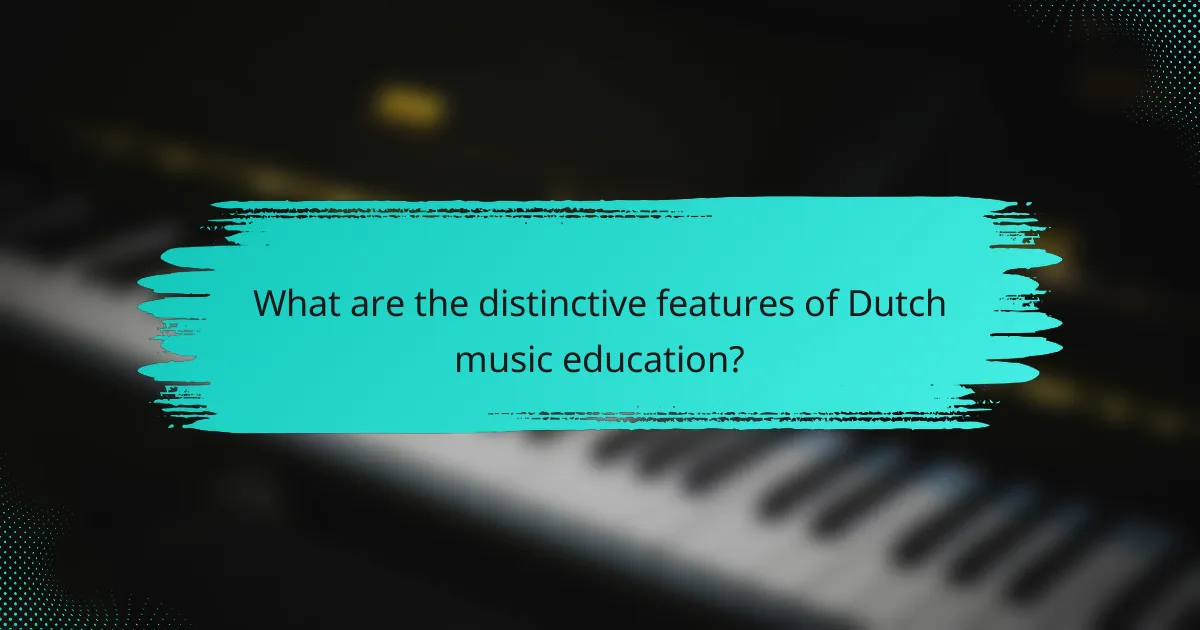
What are the distinctive features of Dutch music education?
Dutch music education emphasizes creativity, collaboration, and inclusivity. Key features include a focus on individual expression, diverse genres, and integration of technology. Unique aspects involve interdisciplinary approaches that blend music with other art forms. The system encourages students to participate in various ensembles, fostering teamwork and cultural exchange.
How does the Orff approach manifest in Dutch classrooms?
The Orff approach in Dutch classrooms emphasizes active participation through music and movement. Students engage with rhythm, improvisation, and ensemble playing, fostering creativity and collaboration. This method aligns with Dutch educational values of inclusivity and experiential learning. Teachers often integrate local musical traditions, enriching the curriculum with cultural relevance. As a result, students develop both musical skills and social cohesion, reflecting the unique attributes of the Orff approach in a Dutch context.
What is the significance of improvisation in Dutch music teaching?
Improvisation is crucial in Dutch music teaching as it fosters creativity and adaptability. It encourages students to explore musical expression beyond traditional boundaries. This approach enhances their ability to collaborate and engage with diverse musical styles, including elements from Japanese music. By integrating improvisation, educators cultivate a dynamic learning environment that values individual artistry and cultural exchange.

How do both countries integrate technology into music education?
Japan and the Netherlands integrate technology into music education through innovative methods and tools. Japan utilizes digital platforms and interactive software to enhance student engagement and creativity. In contrast, the Netherlands emphasizes collaborative online projects and virtual classrooms, fostering cross-cultural exchanges.
Both countries leverage technology to provide diverse learning experiences. Japanese music education often incorporates apps for instrument practice and composition, while Dutch programs focus on digital collaboration tools that connect students globally. These approaches enable learners to explore music in dynamic ways, enriching their educational journeys.
What tools are commonly used in Japanese music education?
Common tools used in Japanese music education include traditional instruments, modern technology, and educational software. Traditional instruments like the koto and shamisen are integral for teaching cultural heritage. Additionally, digital tools such as music notation software and online learning platforms enhance accessibility and engagement. These resources support both theoretical and practical aspects of music education, fostering a comprehensive learning environment.
Which digital platforms are popular in Dutch music classrooms?
Popular digital platforms in Dutch music classrooms include Google Classroom, YouTube, and Spotify. These platforms facilitate collaborative learning, access to diverse music resources, and integration of technology in education. Additionally, platforms like Soundtrap and Noteflight support creative music composition and sharing among students.
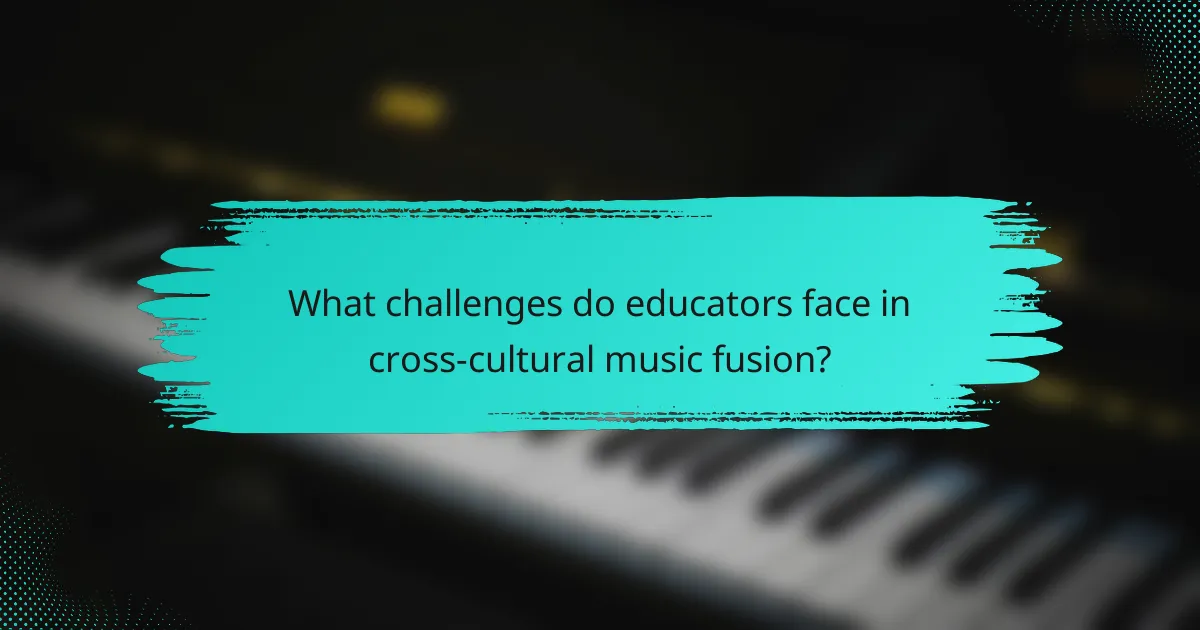
What challenges do educators face in cross-cultural music fusion?
Educators face challenges in cross-cultural music fusion due to differing cultural contexts, pedagogical approaches, and communication styles. These factors can lead to misunderstandings and hinder collaboration. For instance, Japanese music education often emphasizes collective harmony, while Dutch approaches may prioritize individual expression. This divergence complicates the integration of diverse musical traditions. Additionally, educators may struggle with resource availability and varying levels of student engagement in fusion activities. These challenges require adaptive strategies to achieve effective cross-cultural music education.
How do cultural perceptions impact music collaboration?
Cultural perceptions significantly influence music collaboration by shaping how artists approach fusion. Japanese and Dutch musicians may emphasize different values, such as tradition versus innovation, affecting their collaborative dynamics.
For instance, Japanese music often prioritizes subtlety and nuance, while Dutch music may embrace bold experimentation. This divergence can lead to unique creative outcomes when artists learn from each other’s cultural backgrounds.
Moreover, the collaborative process can be enriched by understanding these cultural differences, fostering respect and openness. Such awareness can enhance the fusion experience, leading to innovative musical expressions that reflect a blend of traditions.
Ultimately, cultural perceptions serve as both a bridge and a barrier in music collaboration, influencing the success and nature of cross-cultural projects.
What are common misconceptions about fusion in music education?
Common misconceptions about fusion in music education include the belief that it dilutes cultural authenticity and that it lacks educational rigor. These views overlook how fusion can enhance creativity and cultural understanding. For instance, the Japanese approach often emphasizes traditional techniques, while the Dutch focus on collaborative innovation. Both methods demonstrate that fusion can enrich music education rather than compromise it.

What successful case studies exist in cross-cultural music education?
Successful case studies in cross-cultural music education highlight the fusion of Japanese and Dutch methodologies. One notable example is the collaboration between Japanese taiko drummers and Dutch percussionists. This partnership emphasizes rhythmic techniques and cultural storytelling, enhancing students’ appreciation for diverse musical forms. Additionally, programs in both countries focus on integrating traditional practices with contemporary styles, fostering creativity and innovation in music education. These initiatives demonstrate the effectiveness of blending cultural perspectives to enrich learning experiences.
How have Japanese and Dutch institutions collaborated on music projects?
Japanese and Dutch institutions have collaborated on music projects through exchange programs and joint festivals. These initiatives promote cultural fusion and enhance music education.
Collaborative projects often include workshops that combine traditional Japanese instruments with Dutch music styles. For instance, the Netherlands’ emphasis on contemporary music complements Japan’s rich heritage, creating innovative performances.
Additionally, institutions like the Royal Conservatory in The Hague and Tokyo University of the Arts have established partnerships to share expertise. These collaborations foster cross-cultural understanding and artistic growth.
As a result, both countries benefit from enriched musical landscapes, expanding their global reach and influence in the arts.
What outcomes have been observed in fusion programs?
Fusion programs in cross-cultural music education have led to increased creativity, enhanced collaboration, and deeper cultural understanding. Participants report improved musical skills and broader perspectives on music. These outcomes demonstrate the value of integrating diverse musical traditions, fostering innovation in education. As a result, fusion approaches contribute to a richer educational experience that transcends cultural boundaries.
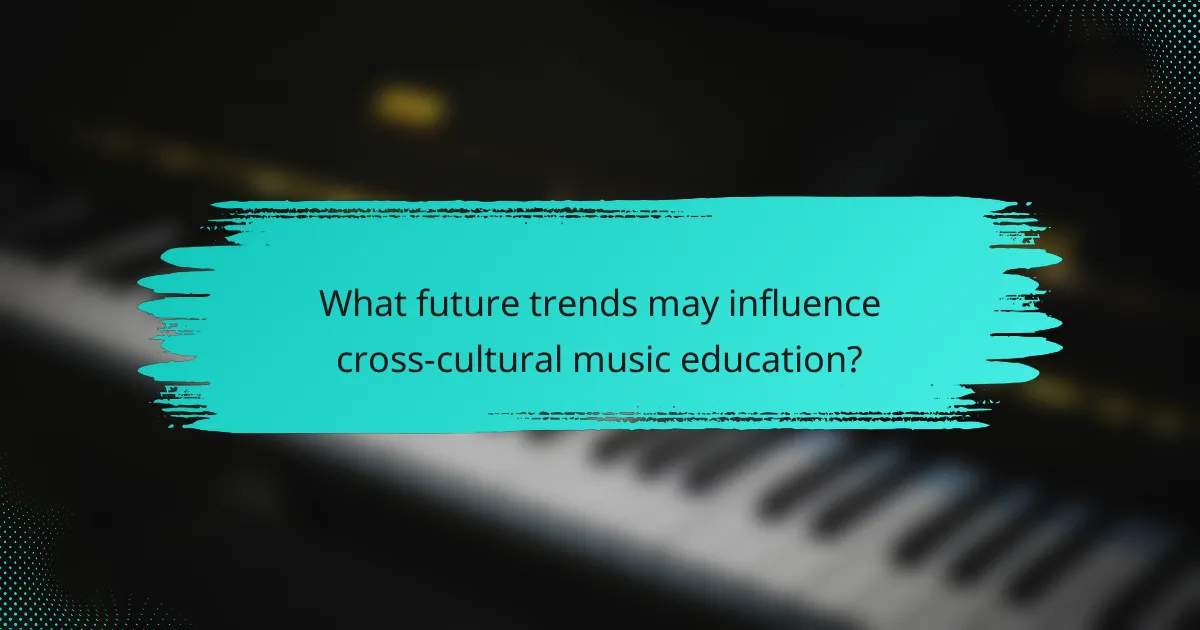
What future trends may influence cross-cultural music education?
Future trends influencing cross-cultural music education include technology integration, increased global collaboration, and a focus on cultural sensitivity. Technology facilitates remote learning and access to diverse musical resources. Global collaboration encourages sharing of pedagogical practices, enriching educational experiences. Cultural sensitivity promotes inclusivity, ensuring diverse voices are represented in curricula. These trends foster a more interconnected and dynamic approach to music education, enhancing understanding and appreciation of different cultural perspectives.
How might globalization affect music teaching methods?
Globalization significantly influences music teaching methods by promoting cross-cultural exchange. Japanese and Dutch approaches to fusion illustrate this impact through diverse pedagogical strategies.
In Japan, traditional music education emphasizes mastery of classical techniques. This approach fosters discipline and deep cultural appreciation. In contrast, the Netherlands encourages innovative fusion, blending various genres and styles. This method cultivates creativity and adaptability among students.
As a result, globalization enriches music education by integrating diverse cultural perspectives. Teachers can draw from a wider array of musical traditions, enhancing students’ learning experiences. This cross-cultural interaction prepares learners for a globalized music industry, fostering collaboration and understanding.
What role will cultural exchange programs play in the future?
Cultural exchange programs will significantly enhance cross-cultural music education by fostering collaboration between Japanese and Dutch musicians. These programs will encourage the fusion of diverse musical styles, creating innovative educational experiences. As a result, participants will gain a deeper understanding of each other’s cultures and musical traditions. This exchange can lead to unique musical compositions that reflect a blend of influences, enriching the global music landscape and promoting cultural appreciation.
What best practices can educators adopt for effective fusion?
Educators can adopt collaborative projects, integrate diverse musical styles, and utilize technology for effective fusion in cross-cultural music education. Encouraging student-led initiatives fosters creativity and understanding. For example, workshops that blend Japanese and Dutch music traditions enhance appreciation and skills. Active listening and respectful dialogue about cultural contexts deepen learning experiences.

